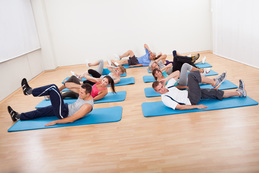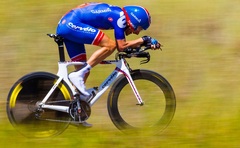
Where: The Lewis Centre - 489 Old Island Highway, Courtenay, BC V9N 3P5
When: Wednesdays @ 1:00-1:30pm Sept. 24th - Nov. 26th, 2014
Cost: Free!
Register: Call the Lewis Centre (250) 338-5371 or Drop-in on Wednesday!
 Dr. Derek will be hosting a weekly abdominal and core stabilization class at the Lewis Centre in Courtenay. Research shows that increasing and maintaining core strength and endurance will prevent the occurrence of back pain or reduce the severity. Also, who doesn't want wash-board Abs! Where: The Lewis Centre - 489 Old Island Highway, Courtenay, BC V9N 3P5 When: Wednesdays @ 1:00-1:30pm Sept. 24th - Nov. 26th, 2014 Cost: Free! Register: Call the Lewis Centre (250) 338-5371 or Drop-in on Wednesday!
1 Comment
 Performance care acts to improve an athlete’s overall success in his or her chosen sport. Difficult training regimes that include repetitive motions (swimming, running, cycling), heavy sets of weight training, and balancing work and life all place a great deal of stress on an athlete’s body. With improper recovery from each workout an excess of inflammation can result. The body responds to this by haphazardly laying down collagen cross-fibres to try and temporarily support the area. These collagen fibres laid down like a cobweb turn into scar tissue if not dealt with conscientiously. This creates a shortened and weak structure that has a higher probability of tearing or becoming injured. This scar tissue: · Restricts motion. · Reduces circulation. · Inhibits nerve function. · Causes ongoing friction and pressure. · Results in the production of yet more cross fibres and adhesions To have the highest performance possible it is very important to reduce these unwanted problems. The best possible way is to keep constant adherence to a stretching and active recovery regime to prevent any build-up of excess tension. Setting up a routine of foam rolling, yoga and massage therapy is a good way keep tissues relaxed, not to mention seeing your soft-tissue specialized chiropractor! In addition, nutrition is a factor to consider using selective eating choices to reduce inflammation with the Anti-Inflammatory Diet. When minor irritations do occur it is important to keep on top of the problems and deal with the area right away. If the injury is nagging long than a few days, then seeking a physical medicine professional is strongly suggested. The gold standard in soft tissue injury management is utilizing Active Release Technique (A.R.T.®). It is a systematic approach to decrease scar tissue adhesions and can help improve performance in any sport. How can A.R.T. improve my sports performance? Even though physical training factors can be modified the bio-mechanical restrictions that have been created with an injury are seldom addressed. These lead to future injuries and inhibits the athlete from reaching his or her full performance potential. Equally important, different athletes may present with identical pain patterns, but each athlete may have completely different structures that are impaired or injured. Before treatment takes place, an extremely specific physical examination must be conducted, which results in a diagnosis. It is important to look past the initial point of pain to identify other structures that are involved in the kinetic chain. Effective treatment of any soft tissue injury (ligaments, muscles, blood vessels, fascia and nerves), requires an alteration in tissue structure to break up the restrictive cross-fiber adhesions and to restore normal function to the affected soft tissue areas. When executed properly, this process: · Substantially decreases healing time. · Treats the root cause of the injury. · Improves athletic performance. With any medical condition, it is important to control the inflammatory process that slows down healing. Often after an injury the body reacts by producing inflammatory products that are to (over) compensate for the stress. It may be an acute accident with a sprained ankle or it may be a chronic whole body condition like arthritis. By eating fresh healthy food it is a essential way to help your body reduce the excess inflammation and will accelerate healing. 1. Vegetables should make up the bulk of your diet. Variety is really the spice of life, particularly when it comes to fruit and vegetables. Aim for at least 10 different types of vegetables/Day with half being cooked and half being raw. Try to plan your meals ahead of time and ideally use fresh or frozen products, no deep fried or salted products. Artichokes - Avocado - Peppers - Broccoli - Beets - Carrots - Cauliflower - Cucumber - Corn - Eggplant - Radish - Spinach - Turnip - Tomatoes - Squash - Snow Peas - String Beans - Zucchini 2. Fruits are also very beneficial to keeping essential nutrients to accelerate healing but they are higher in fructose (sugar) content and can spike an insulin response when eaten in excess. A moderate amount each day (4-5) will help keep the healing process going. Apple - Apricot - Banana - Blackberries - Blueberries - Cantaloupe - Cherries Coconut - Figs - Grapes - Kiwi - Orange - Mango - Nectarine - Papaya - Peach - Pear - Pineapple - Plum - Raspberries - Strawberries - Tangerines - Watermelon 3. Nuts and Seeds are essential sources of minerals, healthy fats, and protein. These are all important elements to fight inflammation. Keeping a bag or container of them at your work or easy to access at home they are the perfect snacking foods when you are hungry. It is best to eat them raw. Almonds - Cashews - Filberts - Flax Seeds - Macadamias - Pecan - Pistachios - Sesame Seeds - Walnuts - Peanuts - Pumpkin seeds 4. Meat & Fish is best to eat wild or free range organically-grown animals. Lamb - Buffalo - Beef (grass fed) - Venison - Elk - Turkey - Salmon (wild) - Sardines - Trout - Halibut - Mackerel If you have any questions or comments please don't hesitate to get in touch with Dr. Derek Vinge at Fit Chiropractic in Courtenay, BC. Phone number 250-871-3674 |
Fit for HealthA clinic with an active approach to modern conservative therapy options. Categories
All
Archives
October 2020
|
